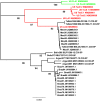Geographic population structure of the sugarcane borer, Diatraea saccharalis (F.) (Lepidoptera: Crambidae), in the southern United States
- PMID: 25337705
- PMCID: PMC4206286
- DOI: 10.1371/journal.pone.0110036
Geographic population structure of the sugarcane borer, Diatraea saccharalis (F.) (Lepidoptera: Crambidae), in the southern United States
Abstract
The sugarcane borer moth, Diatraea saccharalis, is widespread throughout the Western Hemisphere, and is considered an introduced species in the southern United States. Although this moth has a wide distribution and is a pest of many crop plants including sugarcane, corn, sorghum and rice, it is considered one species. The objective was to investigate whether more than one introduction of D. saccharalis had occurred in the southern United States and whether any cryptic species were present. We field collected D. saccharalis in Texas, Louisiana and Florida in the southern United States. Two molecular markers, AFLPs and mitochondrial COI, were used to examine genetic variation among these regional populations and to compare the sequences with those available in GenBank and BOLD. We found geographic population structure in the southern United States which suggests two introductions and the presence of a previously unknown cryptic species. Management of D. saccharalis would likely benefit from further investigation of population genetics throughout the range of this species.
Conflict of interest statement
Figures



Similar articles
-
DNA barcode information for the sugar cane moth borer Diatraea saccharalis.Genet Mol Res. 2008;7(3):741-8. doi: 10.4238/vol7-3gmr470. Genet Mol Res. 2008. PMID: 18767242 Review.
-
Genetic Diversity and Structure of Brazilian Populations of Diatraea saccharalis (Lepidoptera: Crambidae): Implications for Pest Management.J Econ Entomol. 2015 Feb;108(1):307-16. doi: 10.1093/jee/tou040. Epub 2015 Jan 24. J Econ Entomol. 2015. PMID: 26470135
-
The Sugarcane Borer (Lepidoptera: Crambidae) Infests Rice at Low Population Levels in Florida.J Econ Entomol. 2020 Feb 8;113(1):538-542. doi: 10.1093/jee/toz255. J Econ Entomol. 2020. PMID: 31560752
-
Reproductive isolation between two populations of Diatraea saccharalis (F.) (Lepidoptera: Crambidae) from different host plant species and regions in Argentina.Bull Entomol Res. 2016 Oct;106(5):591-7. doi: 10.1017/S0007485316000249. Epub 2016 Apr 26. Bull Entomol Res. 2016. PMID: 27112423
-
Interaction of Cultural, Biological, and Varietal Controls for Management of Stalk Borers in Louisiana Sugarcane.Insects. 2019 Sep 19;10(9):305. doi: 10.3390/insects10090305. Insects. 2019. PMID: 31546775 Free PMC article. Review.
Cited by
-
Identification of Diatraea spp. (Lepidoptera: Crambidae) based on cytochrome oxidase II.PLoS One. 2017 Sep 5;12(9):e0184053. doi: 10.1371/journal.pone.0184053. eCollection 2017. PLoS One. 2017. PMID: 28873431 Free PMC article.
-
An illustrated guide to the identification of the known species of Diatraea Guilding (Lepidoptera, Crambidae, Crambinae) based on genitalia.Zookeys. 2016 Feb 17;(565):73-121. doi: 10.3897/zookeys.565.6797. eCollection 2016. Zookeys. 2016. PMID: 27081337 Free PMC article.
-
The Structure of Rice Stemborer Assemblages: A Review of Species' Distributions, Host Ranges, and Interspecific Interactions.Insects. 2023 Dec 2;14(12):921. doi: 10.3390/insects14120921. Insects. 2023. PMID: 38132595 Free PMC article. Review.
-
Diatraea saccharalis history of colonization in the Americas. The case for human-mediated dispersal.PLoS One. 2019 Jul 24;14(7):e0220031. doi: 10.1371/journal.pone.0220031. eCollection 2019. PLoS One. 2019. PMID: 31339922 Free PMC article.
-
Determination of Genetic Diversity in Chilo partellus, Busseola fusca, and Spodoptera frugiperda Infesting Sugarcane in Southern Malawi Using DNA Barcodes.Insects. 2018 Jun 22;9(3):74. doi: 10.3390/insects9030074. Insects. 2018. PMID: 29932153 Free PMC article.
References
-
- Dyar HG, Heinrich C (1927) The American moths of the genus Diatraea and allies. Proceedings United States National Museum 71: 1–48.
-
- Box HE (1931) The crambine genera Diatraea and Xanthopherne (Lep. Pyralidae). Bull Entomol Res 22: 1–50.
-
- CAB International (1989) Distribution maps of plant pests, Diatraea saccharalis. Series A Agricultural Map 5 (revised). London: CABI.
-
- Box HE (1935) The food plants of the American Diatraea species. Port-of-Spain,Trinidad: Government Printing Office. 1–11.
-
- Box HE (1951) New species and records of Diatraea Guild from northern Venezuela (Lepid:Pyral.). Bull Entomol Res 42: 379–398.
MeSH terms
Substances
Associated data
- Actions
- Actions
- Actions
- Actions
- Actions
- Actions
- Actions
- Actions
LinkOut - more resources
Full Text Sources
Other Literature Sources

